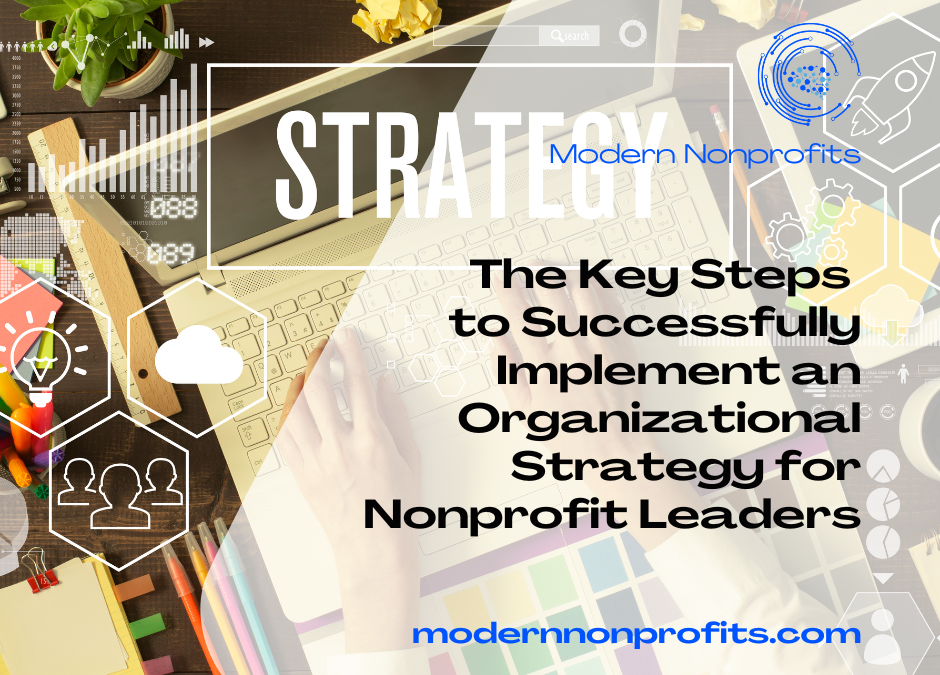Attention nonprofit leaders! Developing a clear organizational strategy is just the first step in creating a successful nonprofit. To achieve your goals, you must also effectively implement the strategy. This requires developing a clear and detailed action plan, communicating the strategy to stakeholders, holding people accountable, monitoring progress, investing in staff development, and celebrating successes. In our latest article, we explore the key steps to successfully implementing an organizational strategy for nonprofit leaders. By following these steps, you can increase your impact, create positive change in your community, and achieve your organization’s mission.
Nonprofit organizations play an essential role in addressing social issues and creating positive change in communities around the world. However, for nonprofits to be effective, they need to have a clear organizational strategy that aligns with their mission and values. Developing an organizational strategy is just the first step in creating a successful nonprofit. To achieve their goals, nonprofit leaders must also effectively implement the strategy. This requires developing a clear and detailed action plan, communicating the strategy to stakeholders, holding people accountable, monitoring progress, investing in staff development, and celebrating successes. In this article, we will explore the key steps to successfully implementing an organizational strategy for nonprofit leaders. By following these steps, nonprofit organizations can achieve their goals, increase their impact, and create positive change in their communities.

Why Nonprofits Need a Clear Organizational Strategy for Success
Nonprofit organizations, as the name suggests, are established with the purpose of serving the public without any profit motive. These organizations work towards various social causes like education, healthcare, environment, and many more. However, to achieve their objectives and succeed in their mission, nonprofits need a clear organizational strategy.
An organizational strategy is a plan of action that guides the decision-making process of an organization. It outlines the goals, objectives, and steps that an organization needs to take to achieve them. For nonprofits, a clear organizational strategy can be the difference between success and failure.
One of the primary reasons why nonprofits need a clear organizational strategy is that it helps them stay focused on their mission and goals. Nonprofits often work towards complex social issues that require a long-term commitment. Without a clear strategy, it is easy for nonprofits to lose sight of their mission and get distracted by other issues or events. A well-defined strategy ensures that nonprofits stay true to their purpose and objectives.
Moreover, a clear organizational strategy helps nonprofits in resource management. Nonprofits often have limited resources, both in terms of finances and human capital. A clear strategy helps nonprofits prioritize their resources and allocate them where they are needed the most. It also helps nonprofits in identifying the areas where they need to invest more resources, such as marketing or fundraising, to achieve their goals.

Another reason why nonprofits need a clear organizational strategy is that it helps them in measuring their progress and success. A clear strategy outlines specific goals and objectives, which can be quantified and measured. This allows nonprofits to evaluate their progress and success, identify areas of improvement, and make changes to their strategy if needed.
Additionally, a clear organizational strategy helps nonprofits in building a strong brand and reputation. Nonprofits that have a well-defined strategy are seen as more professional and trustworthy. This can help them in attracting more donors and volunteers, which is crucial for the success of any nonprofit organization.
In conclusion, nonprofits need a clear organizational strategy for success. A well-defined strategy helps nonprofits stay focused on their mission, prioritize their resources, measure their progress and success, and build a strong brand and reputation. Nonprofits that invest time and effort in developing a clear strategy are more likely to achieve their objectives and succeed in their mission. Therefore, it is crucial for nonprofits to have a clear organizational strategy to make a meaningful impact on the society they serve.

Key Steps to Developing a Strong Organizational Strategy for Nonprofit Leaders
Developing a clear organizational strategy is essential for the success of nonprofit organizations. Here are some steps that nonprofit leaders can take to create a good organizational strategy:
- Define the mission and vision: The first step in developing an organizational strategy is to clearly define the mission and vision of the organization. This helps in setting the direction and purpose of the organization and ensures that all activities are aligned with the overall goals.
- Assess the environment: Nonprofit leaders should analyze the external environment to identify opportunities and threats. This includes understanding the social, economic, and political context in which the organization operates.
- Identify the stakeholders: Nonprofits have a wide range of stakeholders, including donors, volunteers, beneficiaries, and the wider community. Leaders should identify these stakeholders and their needs and expectations to ensure that the organizational strategy is responsive to them.
- Set objectives and goals: Nonprofit leaders should set specific, measurable, achievable, relevant, and time-bound (SMART) objectives and goals that are aligned with the organization’s mission and vision. These objectives and goals should be based on the analysis of the environment and stakeholder needs.
- Develop strategies and tactics: Nonprofit leaders should develop strategies and tactics that enable the organization to achieve its objectives and goals. This involves identifying the resources needed, such as financial and human resources, and the activities required to achieve the desired outcomes.
- Create an action plan: An action plan details the steps that the nonprofit will take to implement the strategies and tactics. The plan should include timelines, responsibilities, and resources required for each activity.
- Monitor and evaluate progress: Nonprofit leaders should regularly monitor and evaluate progress against the objectives and goals set in the organizational strategy. This enables leaders to identify any issues and make necessary adjustments to the strategy and action plan.
- Communicate the strategy: Finally, nonprofit leaders should communicate the organizational strategy to all stakeholders to ensure buy-in and support. This involves developing a communication plan that includes how the strategy will be shared, the key messages to be communicated, and the channels to be used.
Developing a good organizational strategy requires nonprofit leaders to define the mission and vision, assess the environment, identify stakeholders, set objectives and goals, develop strategies and tactics, create an action plan, monitor and evaluate progress, and communicate the strategy. By following these steps, nonprofit organizations can develop a clear organizational strategy that enables them to achieve their mission and create a positive impact on society.

Recommendations for the Nonprofit Leaders
- Involve stakeholders: Nonprofit leaders should involve all stakeholders in the development and implementation of the organizational strategy. This includes donors, volunteers, beneficiaries, and the wider community. By involving stakeholders, leaders can ensure that the strategy is responsive to their needs and expectations.
- Focus on impact: Nonprofit leaders should focus on the impact they are making, rather than just the activities they are doing. This means measuring outcomes and the real difference the nonprofit is making in the community.
- Build a strong team: Nonprofit leaders should build a strong team that is committed to the mission and vision of the organization. This includes hiring the right people and providing them with the necessary training and support to carry out their roles effectively.
- Embrace technology: Nonprofit leaders should embrace technology to improve efficiency and effectiveness. This includes using software for fundraising, social media for marketing, and cloud-based platforms for collaboration.
- Maintain financial sustainability: Nonprofit leaders should ensure that the organization is financially sustainable and that there is a clear plan for generating revenue and managing expenses.
- Monitor external factors: Nonprofit leaders should monitor external factors such as changes in regulations or economic conditions, and adapt the organizational strategy as needed.
- Celebrate success: Nonprofit leaders should celebrate success and acknowledge the contributions of all stakeholders. This helps to build a positive culture and motivate everyone involved in the organization.
By following these recommendations, nonprofit leaders can develop a clear and effective organizational strategy that enables their organization to achieve its mission and create a positive impact in the community.

How to Choose the Right Consultant for Developing the Organizational Strategy
- Relevant experience: Look for a consultant with relevant experience in developing organizational strategies for nonprofit organizations. The consultant should have a track record of success in working with nonprofits in your industry or with similar missions.
- Expertise: The consultant should have expertise in areas relevant to your nonprofit, such as fundraising, program development, and marketing. It’s important to find a consultant who has a deep understanding of the challenges that nonprofits face and who can bring fresh ideas to the table.
- Collaborative approach: Look for a consultant who takes a collaborative approach to work with your organization. The consultant should be willing to listen to your needs and work closely with your team to develop a strategy that aligns with your mission and values.
- Strong communication skills: The consultant should have strong communication skills and be able to explain complex ideas in a clear and concise manner. The consultant should also be able to provide regular updates on the progress of the project and be responsive to your needs.
- References and testimonials: Ask the consultant to provide references and testimonials from past clients. Reach out to these clients to get an idea of the consultant’s strengths and weaknesses and how they worked with the client organization.
- Cost: The cost of the consultant’s services is an important consideration. You should get a clear understanding of the consultant’s fees and any additional costs before signing a contract.
- Cultural fit: It’s important to find a consultant who is a good cultural fit for your organization. The consultant should share your values and be able to work effectively with your team.
By considering these factors, you can choose a consultant who can help your nonprofit organization develop a clear and effective organizational strategy that aligns with your mission and values.

What is the Expected Cost of Developing an Organizational Strategy for Nonprofit Leaders?
The cost of developing an organizational strategy for a nonprofit organization can vary depending on the size and complexity of the organization, the scope of the project, and the experience and expertise of the consultant. Nonprofit leaders should be prepared to invest a significant amount of resources to develop a high-quality organizational strategy.
It is difficult to provide an exact cost estimate without knowing the specifics of the project. However, nonprofit leaders can expect to pay between $5,000 and $50,000 for an organizational strategy project. Projects with larger scope or those requiring more extensive research and analysis may cost more.
Nonprofit leaders should also consider the cost of implementing the organizational strategy. The cost of implementation can vary significantly depending on the goals and objectives outlined in the strategy. For example, if the strategy includes expanding programs, hiring additional staff, or investing in technology, the cost of implementation can be substantial.
When considering the cost of an organizational strategy, nonprofit leaders should keep in mind that the benefits of a well-developed strategy can be significant. A clear and effective organizational strategy can help nonprofit organizations achieve their goals, increase their impact, and build long-term sustainability. It can also help attract new donors, volunteers, and other stakeholders who are essential for the success of the organization. An organizational strategy in combination with a good fundraising plan brings inevitable success and financial sustainability to your organization.

By following these steps, nonprofit leaders can ensure that their organizational strategy is more than just a written document on paper. By implementing the strategy effectively, nonprofit organizations can achieve their goals, increase their impact, and create positive change in their communities.
Are you a nonprofit leader struggling to develop an organizational strategy that aligns with your mission and enables you to achieve your goals? Look no further! As an experienced consultant, I specialize in helping nonprofits like yours develop and implement successful organizational strategies. Let me help you turn your idea into a reality that creates positive change in your community. Contact me today to learn more and schedule a consultation.



I found the 8 steps extremely helpful. Not only step-by-step, but those 8 steps also gave me a lot more ideas on what a nonprofit organization can be, do and accomplish. I’m just starting research on this, as I’m considering creating a nonprofit of some sort as a spin-off from my website to helps animals. Thanks so much!
Dear Debra, I am glad to hear that you found my article helpful. I would be happy you hear about your website and the idea of establishing a nonprofit. Maybe I could be of help to you. I can share some of my experience in the field, and guide you in fundraising.
So many non-profit organizations have come and gone in our community that I began to wonder what was wrong. After reading your post, I now understand why no matter how good one’s motives are in starting a nonprofit organization, without a clear organizational strategy it is bound to fail.
I find these guidelines for developing a strong organizational strategy for nonprofit leaders very helpful, and timely too. I have been talking with some of my neighbors and friends in our community about starting a nonprofit organization that will primarily deal with out-of-school youths. Unfortunately, after the pandemic lockdowns, so many young people in our community did not want to go back to school.
In regard to the funding, what do you suggest we do to raise enough money and get started?
Hello Alice, thanks for your comment. In my 20 years of experience working in the nonprofit sector and leading a disability organization, I may say that developing an organizational strategy is a guideline for the work you do in your nonprofit. This means is a must for a nonprofit to work the right way, and if it is not functional, it has to be restructured and updated.
If you are interested in establishing a nonprofit, I can for sure offer my assistance.
Regardsing the funding, there are plenty of open calls for proposals, but there is still also crowdfunding option. You can join my Discord channel where I am continuously posting open calls for funding for nonprofits, social businesses, starups, and institutions. Find the link here https://discord.gg/BF6pMFgs2M